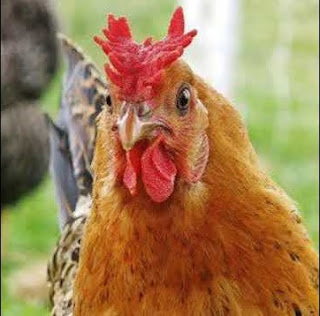Sicilian Buttercup chicken is an Italian chicken breed. They originated from the Island of Sicily, Italy. Buttercup chickens are beautiful by appearance and are mainly raised for ornamental purposes. The colour of their feathers is vibrant and bright. There is a touch of glorious golden colour in their feathers. Their name is suggested according to the cup-shaped comb on their head. In 1835, Sicilian Buttercup chicken was first imported to the United States. These chickens are considered the descendants of the indigenous Siciliana breed of Sicily. In the year 1918, this breed was included in the American Poultry Association Standard of Perfection.
Sicilian Buttercup chickens are usually raised for only ornamental purposes because of their beautiful colourful feathers and the glorious golden touch in their appearance. The other purpose they serve is meat and egg production. These chickens are hardy and good layers. Buttercup hens lay up to 180 eggs on an annual basis. This is a good number of eggs laid per year. The size of their eggs is medium, and the colour of their eggs is white or sometimes tinted. These chickens need to convert their feed actively to laying eggs. This can increase their worth in the market.

Sicilian Buttercup chickens are attractive creatures because of the rich colours of their appearance. There is a variety of colours available in them. Even the colours of their feathers mark a difference in both male and female Sicilian buttercup chickens. The plumage of both male and female Sicilian buttercup chicken is very different. In the case of female buttercup chickens, unique black and gold spangles are running on their bodies parallelly and giving a spotty appearance whereas, in males, there are deep, rich orange coloured feathers with blackish green tails. Their comb is cup-shaped, which makes them different from other breeds.
The average weight of a Sicilian buttercup chicken is in the range of 2.5 to 2.9 kg. There is a slight difference in the weight of both male and female Sicilian buttercup chickens. The hens are usually lighter weight than roosters. The average weight of a Sicilian buttercup rooster is about 2.95 kg whereas the average weight of a Sicilian buttercup hen is about 2.50 kg. They have a fast growth rate, and their egg production is also good. These characteristics make them competitive with other market breeds. The weight in the case of hens varies throughout life because they lay eggs.
The size of Sicilian buttercup chickens is small to medium. The height differs a bit in both male and female Sicilian buttercup chickens. They are petite birds. The average weight in pounds is about 4 to 5 lbs. They have a small size of their body, but the large comb makes them look big. Their feathers are not fluffy but stick tight to their body, so they appear as medium-sized birds. Their large cup comb size helps them survive in the hot climatic conditions. The size stocks after maturity, and they stop growing. The height of the Sicilian buttercup rooster is slightly more than the Sicilian buttercup hen.
Sicilian Buttercup chickens are easy-going birds. They can easily survive in both hot and cold climatic conditions, but extreme climatic conditions are not tolerable. No extra care is required as they actively convert their feed to lay eggs. They are suitable for free-ranging and also excellent foragers. They cannot tolerate confinement. They like to walk and wander around freely without any restrictions. They are calm and intelligent and they are very active & can sense negativity around them. The hens are not broody. They try to take flights on their own, and their maturity rate is also reasonable. Their cup-shaped comb takes time to develop ultimately.
Sicilian Buttercup Chicken Egg Production
Sicilian Buttercup chickens are usually raised for only ornamental purposes because of their beautiful colourful feathers and the glorious golden touch in their appearance. The other purpose they serve is meat and egg production. These chickens are hardy and good layers. Buttercup hens lay up to 180 eggs on an annual basis. This is a good number of eggs laid per year. The size of their eggs is medium, and the colour of their eggs is white or sometimes tinted. These chickens need to convert their feed actively to laying eggs. This can increase their worth in the market.

Sicilian Buttercup Chicken Facts
Sicilian Buttercup chickens are attractive creatures because of the rich colours of their appearance. There is a variety of colours available in them. Even the colours of their feathers mark a difference in both male and female Sicilian buttercup chickens. The plumage of both male and female Sicilian buttercup chicken is very different. In the case of female buttercup chickens, unique black and gold spangles are running on their bodies parallelly and giving a spotty appearance whereas, in males, there are deep, rich orange coloured feathers with blackish green tails. Their comb is cup-shaped, which makes them different from other breeds.
Sicilian Buttercup Chicken Weight
The average weight of a Sicilian buttercup chicken is in the range of 2.5 to 2.9 kg. There is a slight difference in the weight of both male and female Sicilian buttercup chickens. The hens are usually lighter weight than roosters. The average weight of a Sicilian buttercup rooster is about 2.95 kg whereas the average weight of a Sicilian buttercup hen is about 2.50 kg. They have a fast growth rate, and their egg production is also good. These characteristics make them competitive with other market breeds. The weight in the case of hens varies throughout life because they lay eggs.
Sicilian Buttercup Chicken Size
The size of Sicilian buttercup chickens is small to medium. The height differs a bit in both male and female Sicilian buttercup chickens. They are petite birds. The average weight in pounds is about 4 to 5 lbs. They have a small size of their body, but the large comb makes them look big. Their feathers are not fluffy but stick tight to their body, so they appear as medium-sized birds. Their large cup comb size helps them survive in the hot climatic conditions. The size stocks after maturity, and they stop growing. The height of the Sicilian buttercup rooster is slightly more than the Sicilian buttercup hen.
Sicilian Buttercup Chicken Temperament
Sicilian Buttercup chickens are easy-going birds. They can easily survive in both hot and cold climatic conditions, but extreme climatic conditions are not tolerable. No extra care is required as they actively convert their feed to lay eggs. They are suitable for free-ranging and also excellent foragers. They cannot tolerate confinement. They like to walk and wander around freely without any restrictions. They are calm and intelligent and they are very active & can sense negativity around them. The hens are not broody. They try to take flights on their own, and their maturity rate is also reasonable. Their cup-shaped comb takes time to develop ultimately.










0 Comments